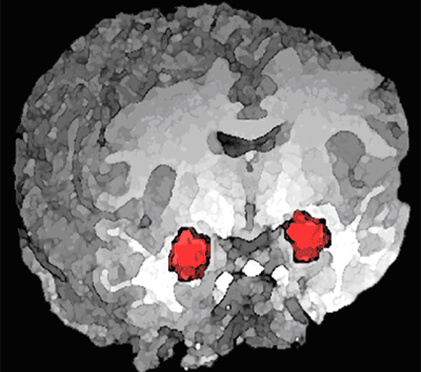These patterns are repeated not only during learning but also for a considerable period of time after it

Diligent students will sometimes give up playing in the yard and stay in class during the break to repeat the material being studied. Now it turns out that the amygdala ("almond" in Greek) in our brain is also inclined to diligence: scientists of the Weizmann Institute of Science have shown that the nerve cells in the amygdala, which are involved in learning and memory processes of an emotional nature, "repeat the learned material" even during the breaks between lessons. These findings, recently published in the scientific journal Nature Neuroscience, shed light on learning mechanisms in the brain and may be relevant in situations where these mechanisms are disrupted, such as anxiety disorders and post-traumatic stress disorder.
The amygdala is an almond-like brain structure located deep in the temporal lobe of many mammals, including humans, and is involved in associative learning processes in which an affinity is formed in the brain between a certain sensory input, for example sound or visual input, with positive or negative experiences. This type of learning is also known as "classical conditioning" or "Pavlovian response", after the Russian scientist Ivan Petrovich Pavlov, who demonstrated it for the first time in dogs: he made dogs secrete saliva in response to a neutral stimulus (ringing a bell) by pairing the ringing for serving food. These findings were groundbreaking in the field of behavioral research - and this work even earned him the Nobel Prize in Physiology or Medicine in 1904. Despite this, the question of what exactly happens in our brains during learning remains largely open.

Prof. Roni Paz and research student Tamar Reitish-Stolero from the Department of Neurobiology at the Weizmann Institute of Science tried to answer this question. They created conditioning between a sound and a pleasant and appetizing aroma (the smell of a banana or melon) and between another sound and a smell that evokes disgust and rejection (propanoic acid, a smell reminiscent of stinky socks). Unlike Pavlov, the researchers were not satisfied with only the behavioral aspects of learning, and recorded the activity of the nerve cells in different centers in the brain in general and in the amygdala in particular.
From the analysis of the activity data of the recorded nerve cells, several findings emerged: First, the researchers identified distinct activity patterns in the triads of nerve cells in the amygdala, which returned in a certain order in time and space (for example, activation of neuron 1, followed by neuron 3 and finally neuron 2 - and God forbid). These activity patterns were different between the positive conditioning (the pleasant smells) and the negative conditioning (the repulsive smells), and they repeated themselves not only during the learning but also during the relatively long breaks between learning repetitions. The researchers concluded from this that these patterns of activity represent a brain encoding mechanism of the new information (the connection between the sound and the smell) and that the repetition of these patterns long after the stimuli have ended, apparently constitutes a kind of "reverse gear" mechanism that helps in the assimilation of the learned material and the formation of the new emotional memory. Interestingly, as learning progressed and the connection between the sound and the smell was internalized - the number of repetitions of the activity pattern in nerve cells decreased, apparently because the learning had already been assimilated and no further repetitions were required.
interrupt the trauma
Our emotions play a central role in learning and memory, and even allow us to survive in a changing environment through conditioning that helps us separate dangerous from safe stimuli and between unpleasant from pleasant stimuli. However, this process can go awry in people suffering from anxiety disorders or post-traumatic stress syndrome (PTSD), preventing them from distinguishing between dangerous and safe situations. In post-traumatic situations, a strong negative reaction, for example paralyzing fear, may arise as a result of an apparently neutral stimulus (some noise, for example), only because in the past this stimulus preceded a traumatic event (for example, screeching brakes that preceded a life-threatening accident).
If the repetitions of the learned material do contribute to the learning process - the question arises what will happen if we interfere with the learning process after a traumatic event, can we thereby prevent the assimilation of the negative conditioning or reduce its intensity - and thus also affect the intensity of the post-traumatic disorder? This therapeutic possibility has previously been raised in behavioral studies. An accurate characterization of the brain activity that reflects the repetition of the negative conditioning may make it possible to interfere with the process of learning and assimilation of the trauma through drugs or more surgical means - brain stimulation that will prevent the repetition of the negative event and only on it.
In the amygdala of humans there are about 12 million neurons, this is compared to about 1.2 billion neurons in the frontal cortex, about 35 billion in the entire cerebral cortex and about 80 billion in the brain in all its parts.
More of the topic in Hayadan:
